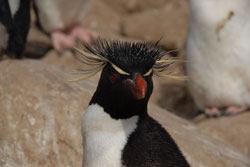Punk Penguins Protected

Graham Harris/Wildlife Conservation Society<br>Rockhopper penguins are now protected in a new park declared by the government of Argentina.<br>
Located to the south of Puerto Deseado in the province of Santa Cruz, Parque Marino Isla Pingüino – which translates to “Penguin Island Marine Park” – will safeguard more than 650 square miles (1,700 square kilometers) of coastal waters strung along almost 60 miles (100 kilometers) of shoreline.
Among the species that will benefit from the park’s creation are Southern rockhopper penguins. Rockhoppers are sometimes described as the “punk-rockers” of penguins due to the “spiked” plumes on their crown. They also have bright yellow “eyebrows,” red eyes, and pink feet. Unlike other penguins which slide on their bellies or walk and awkwardly climb to negotiate obstacles, rockhoppers get around on land by jumping, both legs at once.
The park’s creation represents a joint effort by the Government of Santa Cruz and Argentina’s National Parks Service and is the result of years of study and conservation work by WCS. The new designation will balance wildlife needs with those of the region’s human population by educating local communities about conservation issues and promoting sustainable development activities compatible with conservation goals.
“This decision by Argentine officials represents a significant commitment by the government to protect an extraordinary marine ecosystem,” said Director of the Wildlife Conservation Society’s Latin American Programs Avecita Chicchon. “The creation of this park will help to ensure a future for the threatened species in this region and will protect the area’s unique natural heritage.”
The global population of Southern rockhoppers has fallen sharply by about one-third in the last thirty years to roughly one million pairs. Currently, the species is classified as “vulnerable” by the International Union for the Conservation of Nature (IUCN).
While Argentina’s coastline is largely undeveloped, its wildlife is threatened by pollution caused by offshore oil drilling and transport, and by entanglement in nets used by commercial fishing fleets. WCS has been working in the region since the 1960s and has been involved in the conservation of southern right whales, Magellanic and rockhopper penguins, southern elephant seals and many other unique wildlife species. As part of that effort, WCS is helping to coordinate management of coastal protected areas around the southern cone of South America in Argentina and Chile.
The treaty authorizing the park was signed by President Dr. Cristina Fernandez de Kirchner, of Argentina, Governor Daniel Peralta of the Province of Santa Cruz and by Dr. Patricia Gandini for Argentina’s National Park Service, and is awaiting ratification by the Santa Cruz provincial legislature. After this occurs, a draft of the law establishing the park will be sent to the Argentine Congress for final approval.
The designation of this new protected area was made possible by the generous support of the Liz Claiborne Art Ortenberg Foundation and the Mitsubishi Corporation Foundation for the Americas.
The Wildlife Conservation Society saves wildlife and wild places worldwide. We do so through science, global conservation, education and the management of the world's largest system of urban wildlife parks, led by the flagship Bronx Zoo. Together these activities change attitudes towards nature and help people imagine wildlife and humans living in harmony. WCS is committed to this mission because it is essential to the integrity of life on Earth. Visit: www.wcs.org
Special Note to the Media: If you would like to guide your readers or viewers to a web link where they can make donations in support of helping save wildlife and wild places, please direct them to: www.wcs.org/donation
Media Contact
All latest news from the category: Ecology, The Environment and Conservation
This complex theme deals primarily with interactions between organisms and the environmental factors that impact them, but to a greater extent between individual inanimate environmental factors.
innovations-report offers informative reports and articles on topics such as climate protection, landscape conservation, ecological systems, wildlife and nature parks and ecosystem efficiency and balance.
Newest articles

New theory reveals the shape of a single photon
A new theory, that explains how light and matter interact at the quantum level has enabled researchers to define for the first time the precise shape of a single photon….

Perovskite research boosts solar cell efficiency and product life
An international team led by the University of Surrey with Imperial College London have identified a strategy to improve both the performance and stability for solar cells made out of…

Neuroscientists discover how the brain slows anxious breathing
Salk scientists identify brain circuit used to consciously slow breathing and confirm this reduces anxiety and negative emotions. Deep breath in, slow breath out… Isn’t it odd that we can…



